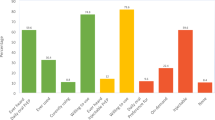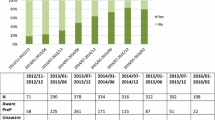Abstract
State-level structural stigma and its consequences in healthcare settings shape access to pre-exposure prophylaxis (PrEP) for HIV prevention among gay, bisexual, and other men who have sex with men (GBMSM). Our objective was to assess the relationships between same-sex marriage laws, a measure of structural stigma at the state level, provider-patient communication about sex, and GBMSM awareness and use of PrEP. Using data from the Fenway Institute’s MSM Internet Survey collected in 2013 (N = 3296), we conducted modified Poisson regression analyses to evaluate associations between same-sex marriage legality, measures of provider-patient communication, and PrEP awareness and use. Living in a state where same-sex marriage was legal was associated with PrEP awareness (aPR 1.27; 95% CI 1.14, 1.41), as were feeling comfortable discussing with primary care providers that they have had sex with a man (aPR 1.63; 95% CI 1.46, 1.82), discussing with their primary care provider having had condomless sex with a man (aPR 1.65; 95% CI 1.49, 1.82), and discussing with their primary care provider ways to prevent sexual transmission of HIV (aPR 1.39; 95% CI 1.26, 1.54). Each of these three measures of provider-patient communication were additionally associated with PrEP awareness and use. In sum, structural stigma was associated with reduced PrEP awareness and use. Policies that reduce stigma against GBMSM may help to promote PrEP and prevent HIV transmission.


Similar content being viewed by others
Data Availability
Data were collected and made available by The Fenway Institute, Boston, MA, USA.
Code Availability
Code is available upon reasonable request of the authors.
References
Centers for Disease Control and Prevention. Estimated HIV incidence and prevalence in the United States, 2015–2019. HIV surveillance supplemental report. 2021; 26(No. 1). http://www.cdc.gov/hiv/library/reports/hiv-surveillance.html. Accessed 16 Feb 2022.
Grant RM, Lama JR, Anderson PL, et al. Pre-exposure chemoprophylaxis for HIV prevention in men who have sex with men. N Engl J Med. 2010;363:2587–99.
Molina J-M, Capitant C, Spire B, et al. On-demand pre-exposure prophylaxis in men at high risk for HIV-1 infection. N Engl J Med. 2015;373:2237–46.
McCormack S, Dunn DT, Desai M, et al. Pre-exposure prophylaxis to prevent the acquisition of HIV-1 infection (PROUD): effectiveness results from the pilot phase of a pragmatic open-label randomised trial. Lancet. 2016;387:53–60.
Finlayson T, Cha S, Xia M, et al. Changes in HIV pre-exposure prophylaxis awareness and use among men who have sex with men—20 urban areas, 2014 and 2017. MMWR Morb Mortal Wkly Rep. 2019;68:597–603.
Raifman J, Nunn A, Oldenburg CE, et al. A quasi-experimental evaluation of a clinical pre-exposure prophylaxis education intervention. Health Serv Res. 2018;53(4):2249–67.
Kanny D, Jeffries WLIV, Chapin-Bardales J, et al. Racial/ethnic disparities in HIV pre-exposure prophylaxis among men who have sex with men—23 urban areas, 2017. MMWR Morb Mortal Wkly Rep. 2019;68:801–6.
Hatzenbuehler ML, Phelan JC, Link BG. Stigma as a fundamental cause of population health inequalities. Am J Public Health. 2013;103:813–21.
Makadon HJ, Mayer KH, Garofalo R. Optimizing primary care for men who have sex with men. JAMA. 2006;296:2362–5.
Mayer KH, Bradford JB, Makadon HJ, et al. Sexual and gender minority health: what we know and what needs to be done. Am J Public Health. 2008;98:989–95.
Hatzenbuehler ML. Structural stigma: research evidence and implications for psychological science. Am Psychol. 2016;71(8):742–51.
Mitchell UA, Nishida A, Fletcher FE, Molina Y. The long arm of oppression: how structural stigma against marginalized communities perpetuates within-group health disparities. Health Educ Behav. 2021;48(3):342–51.
Krakower D, Ware N, Mitty JA, et al. HIV providers’ perceived barriers and facilitators to implementing pre-exposure prophylaxis in care settings: a qualitative study. AIDS Behav. 2014;18:1712–21.
Mimiaga MJ, Goldhammer H, Belanoff C, et al. Men who have sex with men: perceptions about sexual risk, HIV and sexually transmitted disease testing, and provider communication. Sex Transm Dis. 2007;34:113–9.
Sanchez NF, Rabatin J, Sanchez JP, et al. Medical students’ ability to care for lesbian, gay, bisexual, and transgendered patients. Fam Med-Kans City. 2006;38:21.
Calabrese SK, Earnshaw VA, Underhill K, et al. The impact of patient race on clinical decisions related to prescribing HIV pre-exposure prophylaxis (PrEP): assumptions about sexual risk compensation and implications for access. AIDS Behav. 2014;18:226–40.
Grov C, Whitfield THF, Rendina HJ, et al. Willingness to take PrEP and potential for risk compensation among highly sexually active gay and bisexual men. AIDS Behav. 2015;19:2234–44.
Calabrese SK, Underhill K. How stigma surrounding the use of HIV pre-exposure prophylaxis undermines prevention and pleasure: a call to destigmatize ‘Truvada whores.’ Am J Public Health. 2015;105:1960–4.
Eliason MJ, Dibble SL, Robertson PA. Lesbian, gay, bisexual, and transgender (LGBT) physicians’ experiences in the workplace. J Homosex. 2011;58:1355–71.
Lambda Legal. When health care isn’t caring: Lambda Legal’s survey of discrimination against LGBT people and people with HIV. New York: Lambda Legal; 2010.
Obedin-Maliver J, Goldsmith ES, Stewart L, et al. Lesbian, gay, bisexual, and transgender-related content in undergraduate medical education. JAMA. 2011;306(9):972–7.
Ezennia O, Geter A, Smith DK. The PrEP care continuum and Black men who have sex with men: a scoping review of published data on awareness, uptake, adherence, and retention in PrEP care. AIDS Behav. 2019;23:2654–73.
Cahill S, Wade Taylor S, Elsesser SA, et al. Stigma, medical mistrust, and perceived racism may affect PrEP awareness and uptake in black compared to white gay and bisexual men in Jackson, Mississippi and Boston, Massachusetts. AIDS Care. 2017;29(11):1351–8.
Raifman J, Moscoe E, Austin SB, McConnell M. Difference-in-differences analysis of the association between state same-sex marriage policies and adolescent suicide attempts. JAMA Pediatr. 2017;171(4):350–6.
Hatzenbuehler ML, O’Cleirigh C, Grasso C, Mayer K, Safren S, Bradford J. Effect of same-sex marriage laws on health care use and expenditures in sexual minority men: a quasi-natural experiment. Am J Public Health. 2012;102(2):285–91.
Oldenburg CE, Perez-Brumer AG, Hatzenbuehler ML, et al. State-level structural sexual stigma and HIV prevention in a national online sample of HIV-uninfected MSM in the United States. AIDS. 2015;29(7):837–45.
Earnshaw VA, Chaudoir SR. From conceptualizing to measuring HIV stigma: a review of HIV stigma mechanism measures. AIDS Behav. 2009;13(6):1160–77.
Zou G. A modified Poisson regression approach to prospective studies with binary data. Am J Epidemiol. 2004;159:702–6.
Stahlman S, Sanchez TH, Sullivan PS, et al. The prevalence of sexual behavior stigma affecting gay men and other men who have sex with men across sub-Saharan Africa and in the United States. JMIR Public Health Surveill. 2016;2(2):e35.
Kutner BA, Simoni JM, King KM, et al. Does stigma toward anal sexuality impede HIV prevention among men who have sex with men in the United States? A structural equation modeling assessment. J Sex Med. 2020;17(3):477–90.
Furukawa NW, Maksut JL, Zlotorzynska M, et al. Sexuality disclosure in U.S. gay, bisexual, and other men who have sex with men: impact on healthcare-related stigmas and HIV pre-exposure prophylaxis denial. Am J Prev Med. 2020;59(2):e79-87.
Siegler AJ, Mehta CC, Mouhanna F, et al. Policy- and county-level associations with HIV pre-exposure prophylaxis use, the United States, 2018. Ann Epidemiol. 2020;56:24–31.
Funding
This research was supported by the National Institutes for Health Grant No. K01 MH116817 and Johns Hopkins University Center for AIDS Research (Grant No. P30AI094189).
Author information
Authors and Affiliations
Contributions
AS, MDS, LTD, PAC, KHM, and JR contributed to study conception and design. CEO, MJM, and KHM contributed to data collection. Data analysis was performed by AS and JR. The first draft of the manuscript was written by AS and all authors commented on previous versions of the manuscript. All authors read and approved the final manuscript.
Corresponding author
Ethics declarations
Conflict of interest
The authors have no competing interests to declare that are relevant to the content of this article.
Ethical Approval
This is an observational study. The Boston University Medical Campus Institutional Review Board has confirmed that no ethical approval is required.
Consent to Participate
Not applicable.
Consent for Publication
Not applicable.
Additional information
Publisher’s Note
Springer Nature remains neutral with regard to jurisdictional claims in published maps and institutional affiliations.
Supplementary Information
Below is the link to the electronic supplementary material.
Rights and permissions
Springer Nature or its licensor (e.g. a society or other partner) holds exclusive rights to this article under a publishing agreement with the author(s) or other rightsholder(s); author self-archiving of the accepted manuscript version of this article is solely governed by the terms of such publishing agreement and applicable law.
About this article
Cite this article
Skinner, A., Stein, M.D., Dean, L.T. et al. Same-Sex Marriage Laws, Provider-Patient Communication, and PrEP Awareness and Use Among Gay, Bisexual, and Other Men Who have Sex with Men in the United States. AIDS Behav 27, 1897–1905 (2023). https://doi.org/10.1007/s10461-022-03923-y
Accepted:
Published:
Issue Date:
DOI: https://doi.org/10.1007/s10461-022-03923-y




